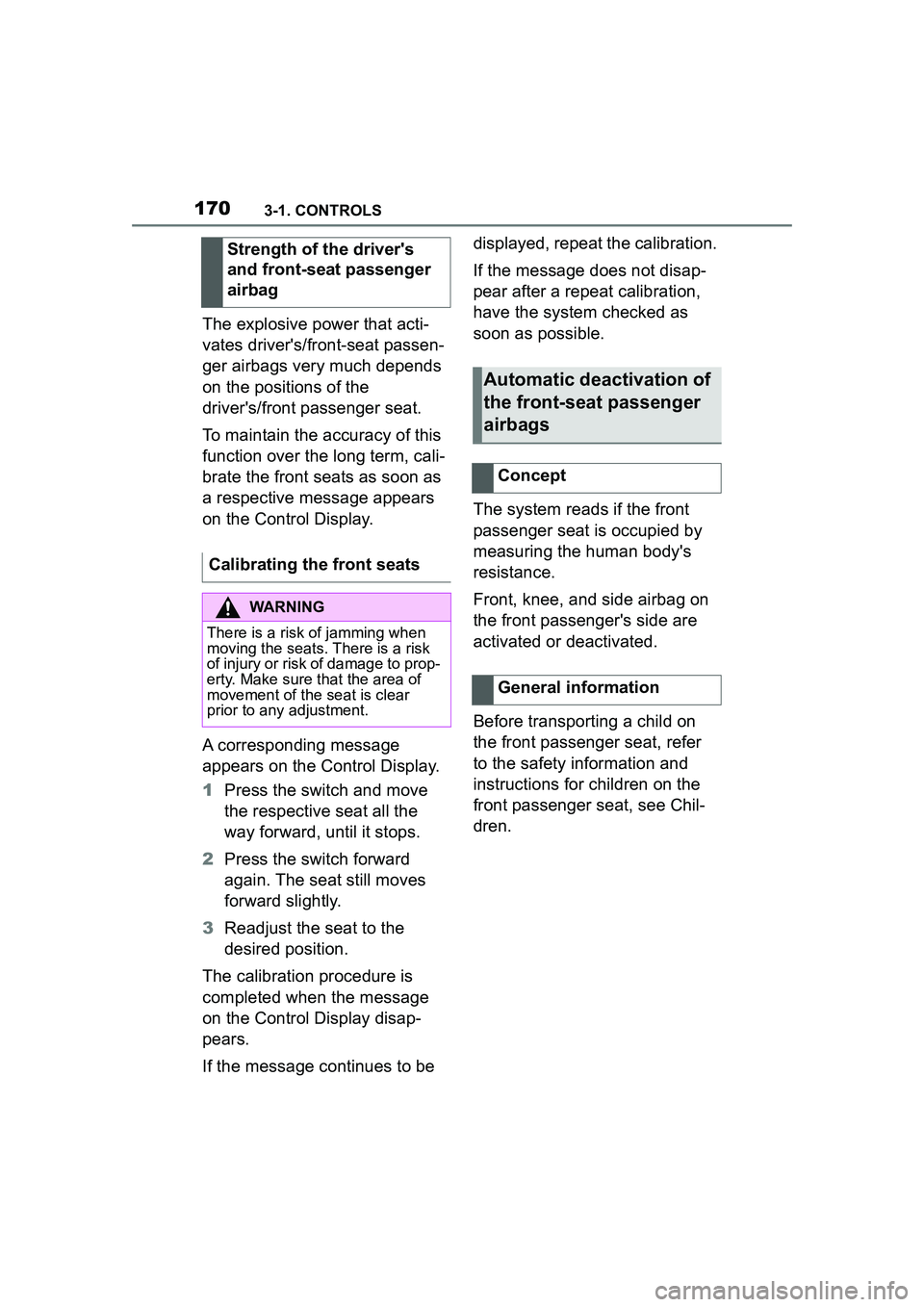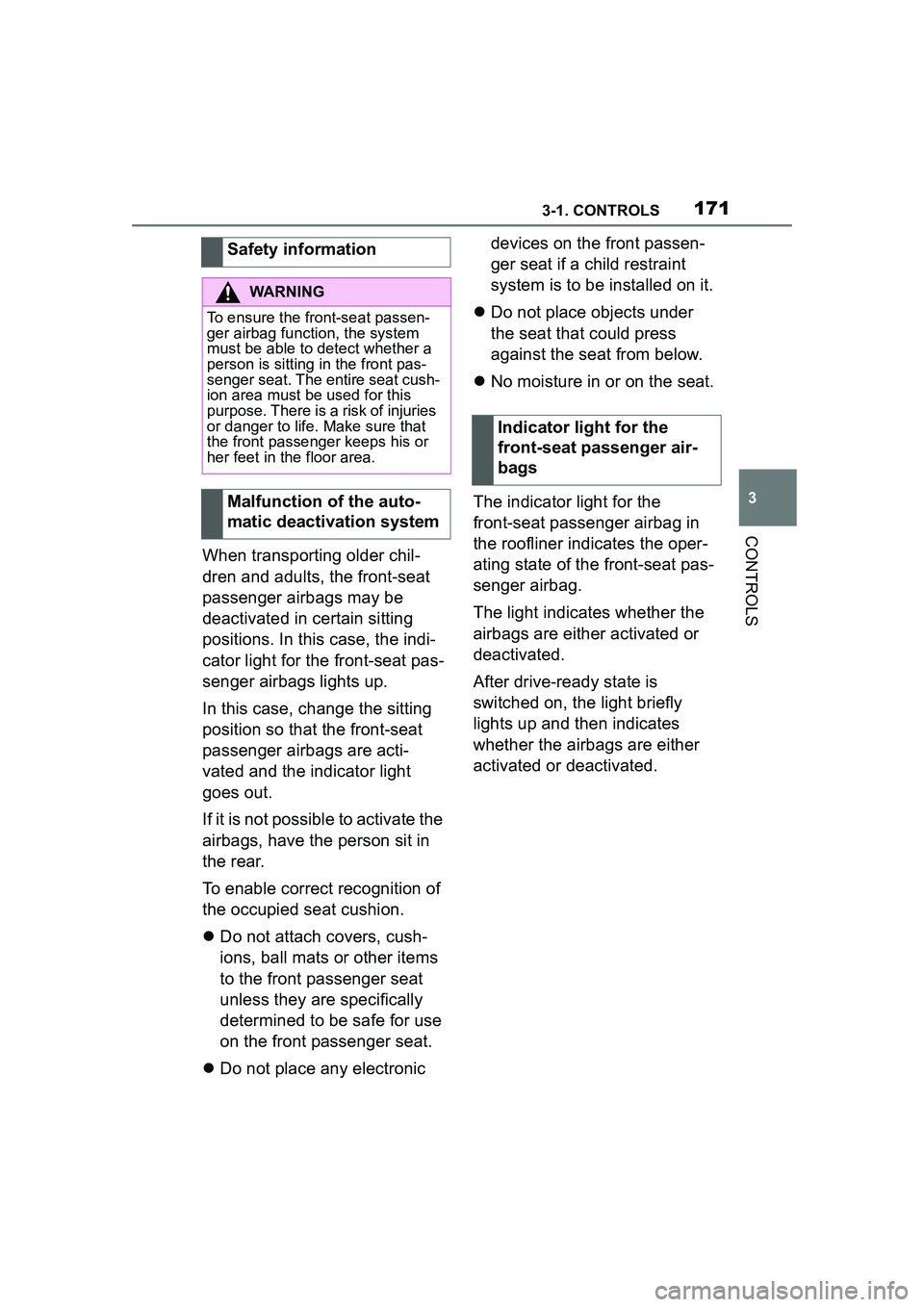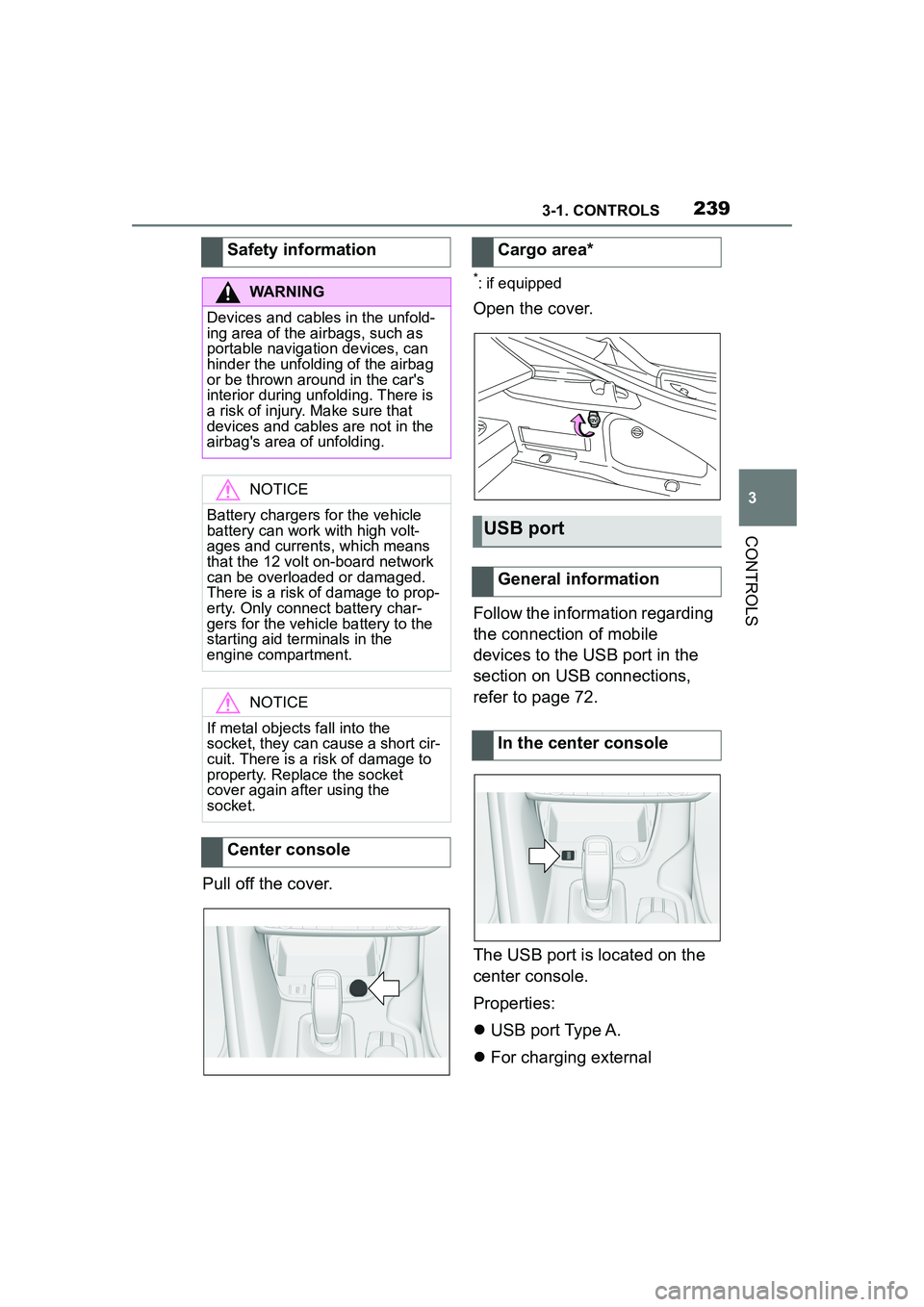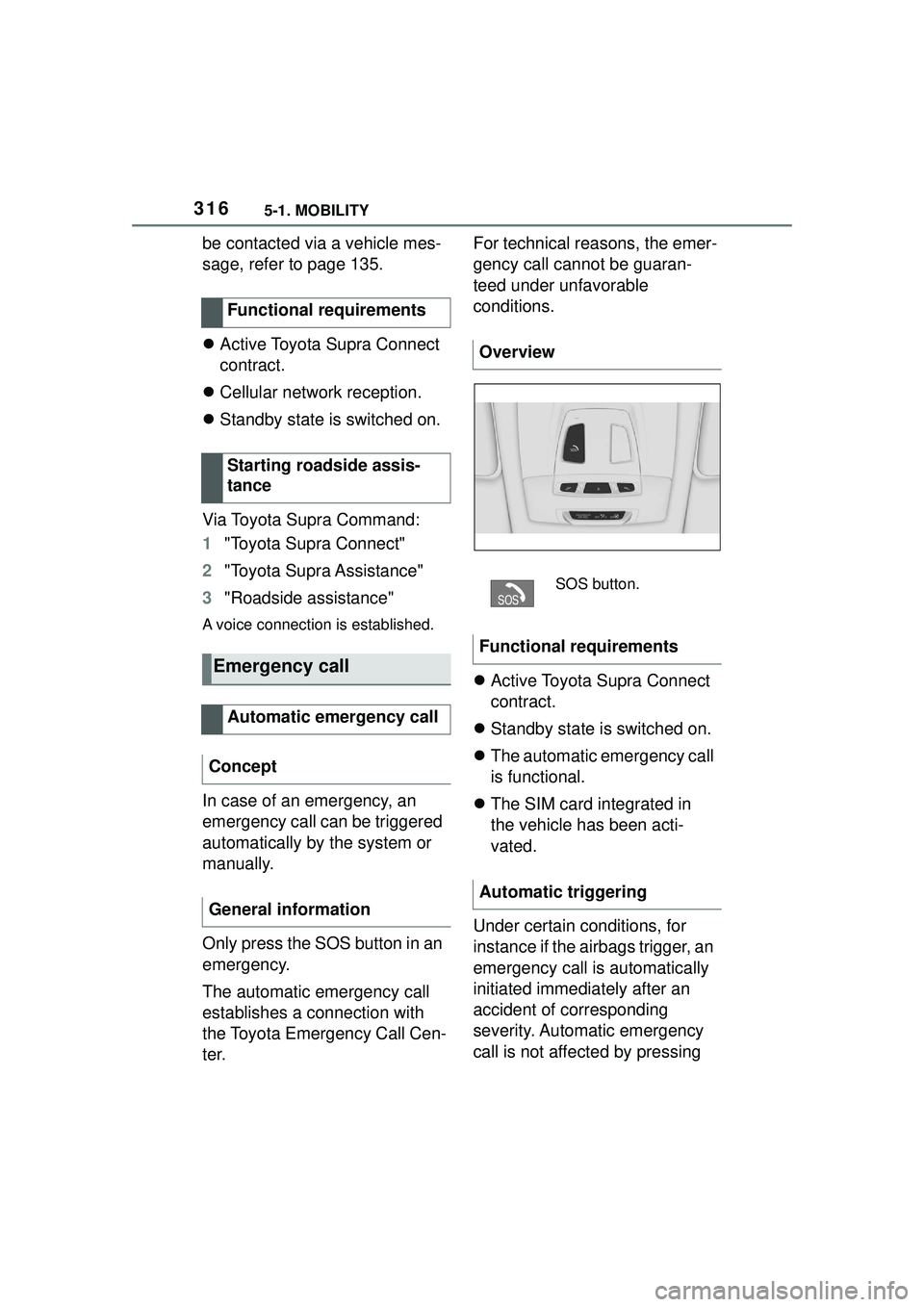2022 TOYOTA GR SUPRA airbag
[x] Cancel search: airbagPage 170 of 356

1703-1. CONTROLS
The explosive power that acti-
vates driver's/front-seat passen-
ger airbags very much depends
on the positions of the
driver's/front passenger seat.
To maintain the accuracy of this
function over the long term, cali-
brate the front seats as soon as
a respective message appears
on the Control Display.
A corresponding message
appears on the Control Display.
1Press the switch and move
the respective seat all the
way forward, until it stops.
2 Press the switch forward
again. The seat still moves
forward slightly.
3 Readjust the seat to the
desired position.
The calibration procedure is
completed when the message
on the Control Display disap-
pears.
If the message continues to be displayed, repeat the calibration.
If the message does not disap-
pear after a repeat calibration,
have the system checked as
soon as possible.
The system reads if the front
passenger seat is occupied by
measuring the human body's
resistance.
Front, knee, and side airbag on
the front passenger's side are
activated or deactivated.
Before transporting a child on
the front passenger seat, refer
to the safety information and
instructions for children on the
front passenger seat, see Chil-
dren.
Strength of the driver's
and front-seat passenger
airbag
Calibrating the front seats
WARNING
There is a risk of jamming when
moving the seats. There is a risk
of injury or risk of damage to prop-
erty. Make sure that the area of
movement of the seat is clear
prior to any adjustment.
Automatic deactivation of
the front-seat passenger
airbags
Concept
General information
Page 171 of 356

1713-1. CONTROLS
3
CONTROLS
When transporting older chil-
dren and adults, the front-seat
passenger airbags may be
deactivated in certain sitting
positions. In this case, the indi-
cator light for the front-seat pas-
senger airbags lights up.
In this case, change the sitting
position so that the front-seat
passenger airbags are acti-
vated and the indicator light
goes out.
If it is not possible to activate the
airbags, have the person sit in
the rear.
To enable correct recognition of
the occupied seat cushion.
Do not attach covers, cush-
ions, ball mats or other items
to the front passenger seat
unless they are specifically
determined to be safe for use
on the front passenger seat.
Do not place any electronic devices on the front passen-
ger seat if a child restraint
system is to be installed on it.
Do not place objects under
the seat that could press
against the seat from below.
No moisture in or on the seat.
The indicator light for the
front-seat passenger airbag in
the roofliner indicates the oper-
ating state of the front-seat pas-
senger airbag.
The light indicates whether the
airbags are either activated or
deactivated.
After drive-ready state is
switched on, the light briefly
lights up and then indicates
whether the airbags are either
activated or deactivated.
Safety information
WARNING
To ensure the front-seat passen-
ger airbag function, the system
must be able to detect whether a
person is sitting in the front pas-
senger seat. The entire seat cush-
ion area must be used for this
purpose. There is a risk of injuries
or danger to life. Make sure that
the front passenger keeps his or
her feet in the floor area.
Malfunction of the auto-
matic deactivation system
Indicator light for the
front-seat passenger air-
bags
Page 172 of 356

1723-1. CONTROLS
The system generally detects
children seated in a child
restraint system, particularly in
child restraint systems required
by NHTSA at the point in time
when the vehicle was manufac-
tured. After installing a child
restraint system, make sure that
the indicator light for the
front-seat passenger airbags
lights up. This indicates that the
child restraint system has been
detected and the front-seat pas-
senger airbags are not acti-
vated.Toyota Supra Safety enables
central operation of the driver
assistance systems.
Depending on how the vehicle is
equipped, Toyota Supra Safety
consists of one or more systems
that can help prevent an immi-
nent collision.
Pre-Collision System, refer to
page 174.
Pre-Collision System (for
pedestrians and bicycles),
refer to page 179.
Lane departure warning, refer
to page 182.
Blind spot monitor, refer to
page 187.
The indicator light
lights up when a child
is properly seated in a
child restraint system
or when the seat is
empty. The airbags
on the front passen-
ger side are not acti-
vated.
The indicator light
does not light up
when, for instance a
correctly seated per-
son of sufficient size
is detected on the
seat. The airbags on
the front passenger
side are activated.
Detected child restraint
systems
Toyota Supra Safety
Concept
General information
Safety information
WARNING
The system cannot serve as a
substitute for the driver’s personal
judgment in assessing visibility
and traffic situation. There is a risk
of an accident. Adjust driving style
to traffic conditions. Watch traffic
closely and actively intervene
where appropriate.
Page 239 of 356

2393-1. CONTROLS
3
CONTROLS
Pull off the cover.
*: if equipped
Open the cover.
Follow the information regarding
the connection of mobile
devices to the USB port in the
section on USB connections,
refer to page 72.
The USB port is located on the
center console.
Properties:
USB port Type A.
For charging external
Safety information
WARNING
Devices and cables in the unfold-
ing area of the airbags, such as
portable navigation devices, can
hinder the unfolding of the airbag
or be thrown around in the car's
interior during unfolding. There is
a risk of injury. Make sure that
devices and cables are not in the
airbag's area of unfolding.
NOTICE
Battery chargers for the vehicle
battery can work with high volt-
ages and currents, which means
that the 12 volt on-board network
can be overloaded or damaged.
There is a risk of damage to prop-
erty. Only connect battery char-
gers for the vehicle battery to the
starting aid terminals in the
engine compartment.
NOTICE
If metal objects fall into the
socket, they can cause a short cir-
cuit. There is a risk of damage to
property. Replace the socket
cover again after using the
socket.
Center console
Cargo area*
USB port
General information
In the center console
Page 314 of 356

3145-1. MOBILITY
If you have been involved in a
collision, perform the following:
1Immediately leave the vehi-
cle and move to a safe place
in order to avoid secondary
collisions. Make sure to turn
the engine switch off to help
prevent the vehicle from
catching fire. If the airbags
have deployed (inflated), the
WARNING
After stopping the vehicle in a
safe place, check the underside of
the vehicle for any leaking brake
fluid, oil or fuel. If any fluid is leak-
ing, stop driving immediately and
have the vehicle inspected by an
authorized Toyota retailer or Toy-
ota authorized repairer, or any
reliable repairer.
Brake and fuel lines run under the
floor of the vehicle. If any of these
lines are damaged, the brakes
may fail or leaking fuel may ignite
and cause a fire.
WARNING
During normal driving, do not turn
off the engine. Turning the engine
off while driving will not cause loss
of steering or braking control, but
the power assist to these systems
will be lost. This will make it more
difficult to steer and brake, so you
should pull over and stop the
vehicle as soon as it is safe to do
so.
WARNING
While driving, if a tire has been
punctured or has ruptured, firmly
grip the steering wheel, gradually
reduce the vehicle speed and
stop the vehicle in a safe place.
Avoid sudden braking and steer-
ing operations as doing so may
cause you to lose control of the
vehicle. Gradually reduce the
vehicle speed and stop the vehi-
cle in a safe place.
If you have been involved
in a collision
Page 315 of 356

3155-1. MOBILITY
5
MOBILITY
airbag related parts will be
extremely hot. Avoid touching
the parts with your hands or
any part of your body.
2 If someone has been injured,
contact emergency services
and request assistance. If
someone has no obvious
external injuries, but they
may have a head injury, keep
their airway open while mov-
ing them as little as possible.
If there is danger of the vehi-
cle being involved in a sec-
ondary collision, move the
injured person to a safe place
while keeping them as hori-
zontal as possible.
The button is located in the cen-
ter console.
The red light in the button
flashes when the hazard warn-
ing flashers are activated.
*: if equipped
1 Unlock the cover, arrow 1,
and fold open, arrow 2.
2 Remove the warning triangle.
Contact the roadside assis-
tance if assistance is needed in
the event of a breakdown.
In the event of a breakdown,
data on the vehicle's condition is
transmitted to the roadside
assistance.
Roadside assistance can also
Hazard warning flashers
Warning triangle*
Roadside assistance
Concept
General information
Page 316 of 356

3165-1. MOBILITY
be contacted via a vehicle mes-
sage, refer to page 135.
Active Toyota Supra Connect
contract.
Cellular network reception.
Standby state is switched on.
Via Toyota Supra Command:
1 "Toyota Supra Connect"
2 "Toyota Supra Assistance"
3 "Roadside assistance"
A voice connection is established.
In case of an emergency, an
emergency call can be triggered
automatically by the system or
manually.
Only press the SOS button in an
emergency.
The automatic emergency call
establishes a connection with
the Toyota Emergency Call Cen-
ter. For technical reasons, the emer-
gency call cannot be guaran-
teed under unfavorable
conditions.
Active Toyota Supra Connect
contract.
Standby state is switched on.
The automatic emergency call
is functional.
The SIM card integrated in
the vehicle has been acti-
vated.
Under certain conditions, for
instance if the airbags trigger, an
emergency call is automatically
initiated immediately after an
accident of corresponding
severity. Automatic emergency
call is not affected by pressing
Functional requirements
Starting roadside assis-
tance
Emergency call
Automatic emergency call
Concept
General information
Overview
SOS button.
Functional requirements
Automatic triggering
Page 344 of 356

344Alphabetical Index
Alphabetical Index
A
A/C button, see Air conditioning
............................................... 228
ABS, Antilock Brake System . 194
ACC, see Dynamic radar cruise control with full-speed range............................................... 203
Acceleration Assistant, see Launch Control..................... 130
Accessories and parts ............... 6
Activated charcoal filter ........ 231
Active Guard, see Toyota Supra Safety .................................... 172
Adaptive brake assist ............ 195
Adaptive variable suspension ............................................... 224
Additional coolant tank cooling, Capacity ................................ 332
Additives, engine oil types .... 297
Air circulation, see Recircu- lated-air mode....................... 229
Air conditioning ...................... 228
Air distribution, manual ......... 230
Air flow, automatic air condition- ing .......................................... 230
Air outlets, see Ventilation .... 231
Air pressure, tires .................. 264
Airbags .................................... 160
Airbags, indicator and warning light........................................ 162
Alarm system ............................ 92
Alarm, unintentional................. 93
All-season tires, see Winter tires ............................................... 274
Antilock Brake System, ABS . 194
Anti-slip control, see VSC ..... 195
Anti-theft protection, locking .. 79
Anti-theft protection, see Lug bolt lock ................................ 289
Apple CarPlay, connection to the vehicle ..................................... 73 Approved axle load ................331
Approved total weight ............331
Assistance when driving off, see
Hill-start assist control.........195
Assistance with breakdown ..315
AUTO program, automatic air
conditioning ........ ..................229
Auto Start/Stop function ........ 116
Automatic air conditioning ....226
Automatic cruise control with Stop & Go ..............................203
Automatic Curb Monitor, exte- rior mirror ..............................106
Automatic deactivation, front-seat passenger airbags...............................................170
Automatic headlight control ..153
Automatic high-beam .............156
Automatic locking ....................91
Automatic transmission.........126
Automatic transmission, Fluid ...............................................332
Automatic transmission, see Automatic transm ission.......126
Automatic unlocking ................91
Automatic vehicle wash .........322
Autonomous Emergency Brak- ing ..........................................192
Axle loads, weights ................331
B
Backrest curvature, see Lumbar support ................ ....................99
Backrest tilt ...............................99
Backrest, seats .........................96
Backrest, width .........................99
Bar for tow-starting/towing....320
Battery, changing, remote con- trol of the vehicle ....................81
Battery, disposing of ..............306
Battery, vehicle .......................305